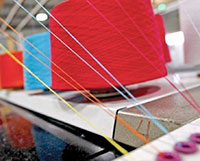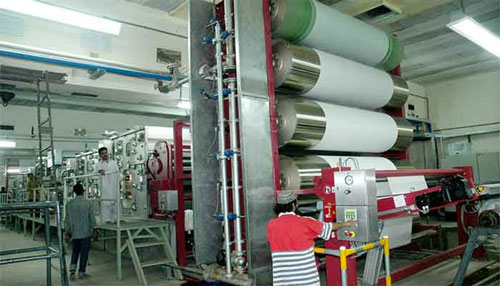FW
GOTS (Global Organic Textile Standard) has released version 6.0. The revision process is undertaken every three years. Key requirements such as certified organic fiber content, the general ban on toxic and harmful chemicals, conventional cotton and virgin polyester as well as the social compliance management have been maintained, while other criteria have become stricter.
When it comes to environmental criteria, product stewardship and environmental health and safety requirements have been introduced for approved chemical formulators. The new version withdraws the relaxation for the additional regenerated and virgin synthetic fiber content for socks, leggings and sportswear. Additionally, product quality standards for color fastness and dimensional stability are now mandatory. Specific new requirements for tampons and food contact textiles have been included. GOTS is a standard for the processing of textiles made from organically produced natural fibers. GOTS defines world-wide recognised requirements that ensure third party certified organic status of textiles with full traceability from field to finished product.
The transition period for users of GOTS to fully comply with the new version will be one year. The standard version and the corresponding implementation manual, as well as the list of changes, are available on the website and can be downloaded.
In January 2020, Egypt’s exports of readymade garments fell three per cent. Egypt’s textile exports fell 0.4 per cent in January 2020 from the same month last year. In January, exports of home furnishing and textiles rose nine per cent and two per cent. Egypt’s textile exports to the United States rose by one per cent year on year in January 2020, while the country’s textile exports to African countries grew by 15 per cent. Egypt’s textile exports to Arab countries dropped six percent in January 2020 compared to January 2019.
The country plans to develop its textile industry with the objective of becoming the next textile factory of the planet. Machinery will be renovated and workers will be trained. The vision is to quadruple textiles and garments exports by 2025. The aim is to support Egypt’s private sector upstream manufacturers’ competitiveness in the world markets. The restructuring program aims at restoring Egypt’s prominent position in the world market and capitalising on the globally renowned fine Egyptian cotton fiber. The program includes the modernisation of spinning, weaving, knitting, dyeing, finishing, printing and confection, based on a product line definition which brings forth added value to Egyptian cotton, from cotton farming to readymade goods with world class levels in terms of quality and efficiency.
The Novel Voronavirus outbreak and its potential ramifications have lowered China’s consumption, more than offsetting any potential positive impacts from the US-China trade truce. China’s consumption is lowered modestly based in part on the initial impacts of the CV outbreak, including lengthened factory shutdowns due to the extended Lunar Holiday. Current impacts include a slowdown across the entire textile sector as travel restrictions and plant shutdowns have reduced commercial activity, and to a lesser extent, a slowdown in consumer demand for apparel and other retail products. The unknown duration and severity of these effects overshadows 2019/20 consumption developments since last month’s forecast.
In contrast, the recently signed trade agreement between the United States and China has reduced uncertainty, as the threat of escalating trade actions (negatively affecting the cotton sector) is replaced, at least in the short term, by greater potential for easing of trade measures put in place during the dispute. By reducing uncertainty, the trade agreement positively impacts expected income growth in CY 2020 and world cotton consumption. Note that a recent reduction in some retaliatory duties by China did not specifically benefit the cotton sector.
A revised version of Bluesign criteria has been released. The intent is to simplify the planning and implementation of goals as well as to increase industry conformity to one set of understood definitions. These include specific guidelines for fiber manufacturers’ production sites and are aimed at bringing into effect a chain of custody throughout the supply chain. Requirements of fiber manufacturing include traceability of recycled fibers for Bluesign approved materials. The updated Bluesign criteria will bring the industry much closer to reducing impact and increasing safety for both end consumers and workers. Bluesign hopes that these will allow system partners to continue to strive toward industry excellence and to create a platform to enable them to be the leaders in their fields.
These revisions mark the first occasion in which the criteria revisions have taken place through close stakeholder collaboration. Starting in 2019, a number of stakeholders comprising brands, NGOs, fellow industry consultants and chemical suppliers provided over 30 points for consideration with the aim of raising the benchmark and ensuring industry conformity.
Bluesign aims at responsible and sustainable manufacturing of textile consumer products, and it is continually improving its services to meet this goal. To ensure this continuous improvement, Bluesign has revised its criteria in order to align with the industry’s efforts and to raise the bar in order to accelerate achievements.
Garment workers in Asia are facing destitution in the wake of COVID-19 epidemic. Factories are closing in Sri Lanka, Bangladesh, Indonesia, Albania and across Central America. The situation for garment workers in Cambodia and Myanmar is already dire. Some factories are said to have already sacked workers without pay. Many workers cannot afford to live on their normal salaries and are therefore in high levels of debt; they are now likely to default on their loans. Factories in garment-producing countries including Bangladesh, Cambodia and Vietnam are about to close due to a shortage of raw materials from China and declining orders from western clothing brands.
Millions of workers in supply chains are likely to fall into crippling poverty as they lose their jobs and struggle to provide for their families. Poverty wages, unsafe and unsanitary workplaces and poor health already make the garment workforce highly vulnerable to the worst effects of the virus.
It is doubtful garment workers would be able to save enough from their salaries to have funds to fall back on if they lose their jobs or are unable to go into work. Many of these workers live in countries where labor laws and protections are not upheld.
 A sewing machine brand, Hikari has recorded great achievements in new technologies and automation. Two of its products have been widely imitated by other companies in the industry. The brand is favored by global customers as one of the most promising brands in the world. M Srinivasan,India Head, elaborates on its operations in India.
A sewing machine brand, Hikari has recorded great achievements in new technologies and automation. Two of its products have been widely imitated by other companies in the industry. The brand is favored by global customers as one of the most promising brands in the world. M Srinivasan,India Head, elaborates on its operations in India.
Hikari makes specially pressurized machines in India. This helps the brand to increase its efficiency by around 30 percent. All its machines are equipped a smart system that reduces manpower and human errors. “We also provide immediate after sales service,” says M Srinivasan, India Head of the brand.
Hikari has an office in Tirupur - a knitwear hub with 5,000 factories. In a year, the company buys one lakh knitting machines for producing undergarments and T-shirts.. “We have clients in New Delhi and Bengaluru too like Shahi Exports and Orient Craft etc. In Kolkata we have biggies like Lux, Rupa & Co. and Amul etc. By 2022 we hope to cover the whole of India,” says Srinivasan.
Even though garment manufacturers are not expanding their business in China, yet they have not really lost business in that country and are holding out. In India too, Hikari’s business is growing as even unskilled operators can easily run its user’s friendly machines emphasizes Indian head, HIKARI. He optimistically avers that Government subsidies will ensure greater access to these domestic garment makers and shall help boost the industry growth outlook and near term prospects.
"The recently approved Textile Policy 2020-25 of Pakistan sets an ambitious target of increasing the country’s textile exports to $28 billion by 2025. To achieve this target, the country aims to boost cotton production from nine million bales to 20 million bales within five years. It also aims to improve the quality of cotton seeds besides introducing latest farming and picking practices will be introduced. The government will also emphasise on the production of long staple cotton to reduce dependence on imported cotton."
 The recently approved Textile Policy 2020-25 of Pakistan sets an ambitious target of increasing the country’s textile exports to $28 billion by 2025. To achieve this target, the country aims to boost cotton production from nine million bales to 20 million bales within five years. It also aims to improve the quality of cotton seeds besides introducing latest farming and picking practices will be introduced. The government will also emphasise on the production of long staple cotton to reduce dependence on imported cotton.
The recently approved Textile Policy 2020-25 of Pakistan sets an ambitious target of increasing the country’s textile exports to $28 billion by 2025. To achieve this target, the country aims to boost cotton production from nine million bales to 20 million bales within five years. It also aims to improve the quality of cotton seeds besides introducing latest farming and picking practices will be introduced. The government will also emphasise on the production of long staple cotton to reduce dependence on imported cotton.
The policy highlights the issue of lack of availability of Man Made Fiber (MMF) at competitive prices. At present, Pakistan’s consumption is around 30 per cent as compared to its 70 per cent consumption of cotton. In future, it aims to increase this ratio to 50:50.
Simplifying application for temporary import schemes
So far, limited access to raw materials has prevented Pakistan from achieving its full export potential and product diversification. It now plans to simplify the application process for temporary import schemes besides allowing inter/intra-bond/scheme transfers of intermediate products to direct or indirect exporters and commercial importers. This will enable the country to achieve price competitiveness and product diversification.
product diversification. It now plans to simplify the application process for temporary import schemes besides allowing inter/intra-bond/scheme transfers of intermediate products to direct or indirect exporters and commercial importers. This will enable the country to achieve price competitiveness and product diversification.
The withdrawal of zero rating or SRO 1125 has created a serious liquidity crisis for the export sector. Though the government had withdrawn the zero rating system to collect sales tax from domestic sales, it has completely failed and billions of rupees of refunds are stuck in the system.
Increase in overall LTFF limit
The textile policy also increases the overall limit of LTFF (long term financing facility) by $1 billion per year for each upcoming year. The LTFF scheme will now be extended to the entire value chain including building infrastructure costs of garments and knitwear sectors. LTFF for projects will be provided to achieve international sustainability requirements i.e. effluent plants, etc.
The policy also reveals that the ministry aims to set up state-of-the-art industrial zones to accelerate exports by providing Plug and Play facilities, specially for garmenting units. Workers’ residential colonies are to be developed through the prime minister’s housing scheme around SEZs.
Limiting DLTL to garments and made-ups
Under the Textile Policy 2020-25, after 2021, the provision of Drawback of Local Taxes and Levies (DLTL) will be limited to garments and made-ups. Currently, it is provided to segments that include four percent for garments, three percent for made ups and two percent for processed. Additionally, 2 per cent duty drawback is provided for non-traditional markets and 50 per cent is given unconditionally and remaining on 10 per cent growth.
The textile policy also highlights that through the Finance Act 2013, the government had raised the General Rate of Minimum Turnover Tax under Section 113 of the Income Tax Ordinance 2001 to 1.5 per cent through the Finance Act, 2019. However, now it plans to revert to 0.5 per cent tad and also include indirect exporters under this tax.
"The Department for Promotion of Industry and Internal Trade (DPIIT) recently clarified that single brand retailers, owned by foreign companies, can fulfill their local sourcing requirements by procuring goods produced in units based in special economic zones (SEZs). It further clarified these goods to be sourced by the single brand retailers need to be manufactured in India."
 The Department for Promotion of Industry and Internal Trade (DPIIT) recently clarified that single brand retailers, owned by foreign companies, can fulfill their local sourcing requirements by procuring goods produced in units based in special economic zones (SEZs). It further clarified these goods to be sourced by the single brand retailers need to be manufactured in India.
The Department for Promotion of Industry and Internal Trade (DPIIT) recently clarified that single brand retailers, owned by foreign companies, can fulfill their local sourcing requirements by procuring goods produced in units based in special economic zones (SEZs). It further clarified these goods to be sourced by the single brand retailers need to be manufactured in India.
India allows 100 per cent FDI for single brand retail. However, till 2018, these firms needed DPIIT’s permission to invest above 49 per cent in this sector. In 2019, the government amended the FDI policy to allow single brand retailers to set up their online operations without having a physical store in the country. This enables retailers to test the market before making large investments.
The amendment also stated that foreign retailers with more than 51 per cent FDI in the fashion sector need to source a minimum 30 per cent of the value of purchased goods domestically. However, they can meet this requirement incrementally within the first five years of operations in India.
Regardless of these new amendments, foreign retailers are not too keen to invest in India as the government does not support them in either procuring land and local sourcing or setting up their manufacturing facilities. Lack of skilled labour and weak infrastructure also dissuade them from investing in India’s single brand retail sector. Lack of supply chain, skilled labor prevents brands from shifting production.
does not support them in either procuring land and local sourcing or setting up their manufacturing facilities. Lack of skilled labour and weak infrastructure also dissuade them from investing in India’s single brand retail sector. Lack of supply chain, skilled labor prevents brands from shifting production.
The Indian retail sector has been attracting foreign investments through such intermittent relaxations in the last five years. This has enabled globally known retailers like H&M, Starbucks, Walmart, Nokia, Sony, and IKEA to establish and reinforce their presence in India
Licensing agreements over FDIs
In the past, single brand retailers, such as Zara and Marks & Spencer, have partnered Indian retail conglomerates through license agreements instead of taking the FDI route. For instance, Forever 21 recently filed for bankruptcy in the US – with plans to exit international locations in Asia and Europe. However, its India operations, will continue but as a franchise operation run by Aditya Birla Fashion and Retail.
Despite these much-touted relaxations, several single-brand retailers might prefer entering the Indian market through partnerships as it gives them access to local expertise in navigating India’s highly segmented though vast market.
Garment and clothing companies in India face a 30 per cent drop in their sales and profitability if the COVID-19 crisis continues. C losure of shopping spaces such as malls and high street stores, along with the general advisory to avoid public spaces, has crippled demand. Many other issues are likely to crop up if the current crisis continues. Mainly, there will be the problem of working capital shortage. The money flow will be inadequate for payment of taxes, discharge of bank interest, repayment of loans, statutory dues etc.
India can expect a 0.5 per cent hit on economic growth this fiscal if the Coronavirus pandemic lasts longer. The economic impact will be significant and long term if the virus continues for longer. Widening of the fiscal deficit is also feared. NPA levels in the banking sector are expected to increase. Exports and imports are likely to contract. While hospitality, tourism, aviation, auto and auto ancillary will be hit hard, pharma and healthcare will benefit from the pandemic. Indian garment manufacturers will need to look at other alternatives, including local sourcing, which in turn may increase the cost of finished goods by three per cent to five per cent. In addition to this, identifying vendors in such a short time can take a toll on lead times, quality and cost.
Make it British was to be held in the UK, March 17 to 18, 2020 but has been postponed because of COVID-19 and now a virtual event will take place online at the end of May. The virtual show will exactly be the same as the real show and will include everything that the live event does, including the conference, the networking and the workshops. Each exhibitor will have their own virtual booth that they will be able to man for the duration of the show using a webcam that can be attached to any computer. All visitor tickets will automatically be transferred to the virtual expo in May, as well as being redeemable against tickets for a rescheduled live show.
Make it British plays a vital service in championing manufacturing close to home. It draws attention to those who are operating in the UK and then encourages people to place orders that respect the unique position manufacturing in the UK can bring. Across the UK, fashion manufacturing employs over 43,000 people with nearly 3,900 companies. Textile manufacturing in the UK is also constantly developing.
Virtual trade shows could be the future of events in the coming months. They create a sense of community while everyone can’t be together.












